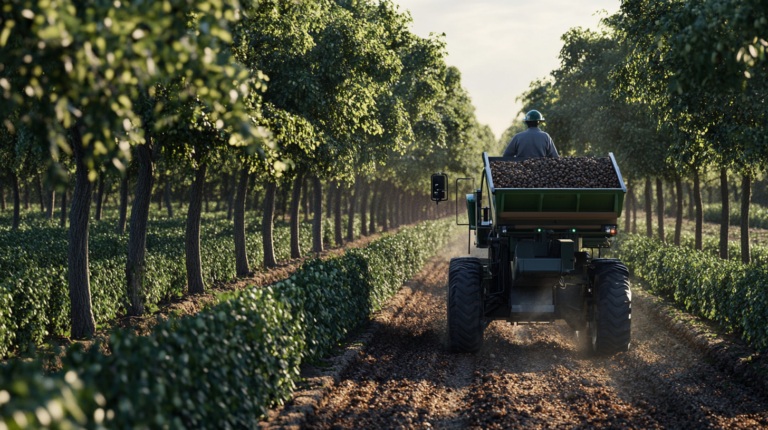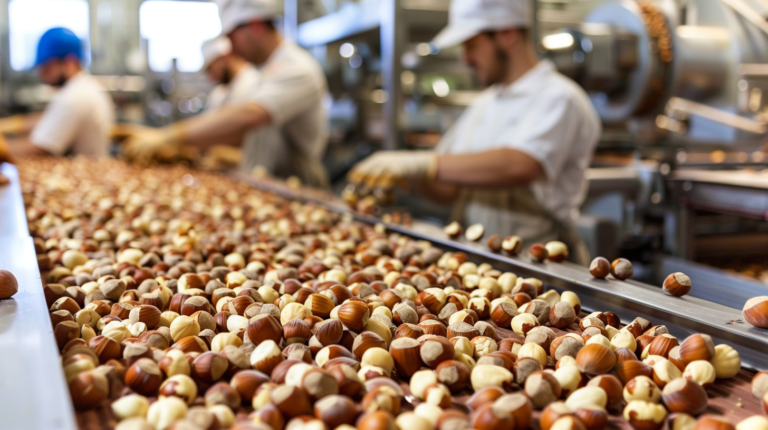The Economics of Hazelnut Production: Costs vs. Revenue
The economics of hazelnut production involves a detailed analysis of both costs and revenue. Here is a comprehensive overview based on the provided sources:
Establishment Costs
Land and Initial Setup
Establishing a hazelnut orchard involves significant initial investments, particularly in land acquisition and setup. The cost of land suitable for hazelnut farming ranges from $5,000 to $12,000 per acre (FinModelsLab, n.d.). This variability depends on factors such as location, soil quality, and existing infrastructure.
The initial setup includes costs for equipment, irrigation systems, fencing, and other necessary infrastructure. Equipment costs can range from $10,000 to $50,000, depending on the type and quality of machinery required. Irrigation systems, essential for maintaining optimal soil moisture, can cost between $5,000 and $20,000 (FinModelsLab, n.d.). These initial investments are crucial for setting up a productive and sustainable hazelnut orchard.
Planting and Maintenance
The cost of hazelnut seedlings or saplings ranges between $1 and $3 per plant. The number of plants per acre depends on the planting density, which can be standard or double density. Labor costs for planting, maintenance, and harvesting range from $12 to $15 per hour (FinModelsLab, n.d.).
Additional costs include fertilizers, chemicals, and machinery maintenance. For a standard-density orchard, the first-year cash cost is approximately $2,839 per acre, while for a double-density orchard, it is around $4,556 per acre (Julian et al., 2011). These expenses cover the essentials of nurturing the young plants until they start bearing fruit.
Production Costs and Revenue
Production Timeline
Hazelnut orchards take several years to reach full production. Production typically begins in the third year with a small yield, gradually increasing to full production by the eleventh year. For a standard-density orchard, production starts at 75 pounds per acre in the third year and reaches 3,200 pounds per acre at full production (Julian et al., 2011).
Double-density orchards, where trees are planted closer together, can achieve positive cash flow earlier, usually by the fifth year, compared to the seventh year for standard-density orchards (Julian et al., 2011). The closer planting density allows for higher early yields, offsetting the higher initial costs more quickly.
Revenue
A successful hazelnut production business can generate annual revenues ranging from $50,000 to $500,000, depending on the scale of operation and market conditions (FinModelsLab, n.d.). The profit margins for hazelnut production businesses can range from 20% to 40%, influenced by factors such as market demand, production costs, and sales strategies (FinModelsLab, n.d.).
The revenue potential is significant, especially as global demand for hazelnuts continues to rise. Hazelnuts are a key ingredient in many popular products, such as Nutella, chocolates, and health bars, which drives consistent demand.
Profitability Analysis
Standard-Density Orchard
For a standard-density orchard, positive cash flow begins in the seventh year, with gross income exceeding total cash costs by $63 per acre. However, due to the high establishment costs, the cumulative economic returns remain negative, resulting in a net projected return of -$2,397 per acre annually when amortized over 25 years (Julian et al., 2011). This indicates that, while standard-density orchards can eventually generate positive cash flow, they may never fully recover the initial establishment costs, leading to long-term financial challenges.
Double-Density Orchard
Double-density orchards, although more expensive to establish, offer better profitability. Positive cash flow starts in the fifth year, with gross income exceeding total cash costs by $48 per acre. The cumulative cash flow turns positive in the eighth year, with a surplus of $1,242 per acre (Julian et al., 2011). Despite the higher initial costs, double-density orchards provide earlier and higher returns, making them more profitable in the long run. This planting strategy maximizes the land’s productivity and accelerates the return on investment.
Value-Added Processing
Investing in value-added processing equipment can significantly enhance profitability. Equipment such as roasters and grinders, which range from $3,000 to $25,000, allows farmers to produce products like roasted hazelnuts and hazelnut butter (FinModelsLab, n.d.). These value-added products can attract a higher price in the market, diversifying revenue streams and increasing overall profitability.
Value-added processing not only boosts revenue but also helps farmers establish a loyal customer base. Consumers are often willing to pay a premium for high-quality, locally processed products. This strategy can help mitigate the volatility of raw hazelnut prices and stabilize income.
Economic Impact of Hazelnut Production
Local Economies
Hazelnut production has a significant impact on local economies, particularly in regions where hazelnut farming is prevalent. The industry provides employment opportunities, from farm labor to processing and distribution. The revenue generated from hazelnut farming supports local businesses and contributes to the economic development of rural areas.
National Economy
On a national level, countries like Turkey, which is the largest producer of hazelnuts, benefit immensely from hazelnut exports. In 2019, Turkey generated over $2 billion in revenue from hazelnut exports, underlining the importance of this crop to the national economy (TRT World, 2021). The success of the hazelnut industry supports numerous sectors, including agriculture, processing, and logistics, making it a vital part of the national economy.
Export Market
The global demand for hazelnuts, particularly from countries with significant confectionery industries, ensures a steady export market. Key importers include the European Union and the United States, where hazelnuts are used extensively in food products. The stable demand from these markets provides a reliable source of income for hazelnut producers.
Challenges in Hazelnut Production
Climate and Environmental Factors
Hazelnut production is highly sensitive to climate conditions. Factors such as frost, drought, and excessive rainfall can significantly impact yield and quality. Farmers must invest in appropriate irrigation and frost protection systems to mitigate these risks, adding to the overall production costs (Julian et al., 2011).
Pest and Disease Management
Pests and diseases pose another significant challenge. Effective management requires regular monitoring and the use of pesticides and fungicides, which can be costly. Integrated pest management strategies, which combine biological, cultural, and chemical controls, can help reduce reliance on chemical treatments and lower costs in the long run (Julian et al., 2011).
Market Fluctuations
The hazelnut market is subject to fluctuations in supply and demand, which can affect prices and profitability. Factors such as changes in consumer preferences, competition from other nut producers, and global economic conditions can influence market dynamics. Farmers need to adopt flexible marketing strategies and consider value-added processing to mitigate the impact of market volatility.
Future Prospects
Technological Advancements
Advancements in agricultural technology hold promise for the future of hazelnut production. Innovations such as precision agriculture, which uses data and technology to optimize farming practices, can enhance productivity and reduce costs. Technologies like drones and sensors can help monitor crop health and manage resources more efficiently (Julian et al., 2011).
Sustainable Practices
There is a growing emphasis on sustainable farming practices to ensure the long-term viability of hazelnut production. Practices such as organic farming, agroforestry, and soil conservation can enhance soil health and biodiversity, making hazelnut farming more sustainable. Adopting these practices can also attract environmentally conscious consumers and open up new markets.
Expanding Global Market
The global market for hazelnuts is expected to expand further, driven by increasing consumer awareness of health benefits and the demand for plant-based protein sources. This growth presents opportunities for hazelnut producers to increase production and explore new markets. Developing robust marketing strategies and forming partnerships with food manufacturers can help capitalize on this growing demand.
Government Support
Government policies and support play a crucial role in the growth of the hazelnut industry. Subsidies, grants, and research funding can help farmers adopt new technologies and practices, improve productivity, and reduce costs. Collaborative efforts between governments, research institutions, and industry stakeholders can drive innovation and ensure the sustainability of the hazelnut industry.
Conclusion
The economics of hazelnut production involves a careful balance of costs and revenue. While the initial establishment costs are substantial, particularly for land and infrastructure, the potential for high revenue and profit margins exists. Double-density orchards, despite higher initial costs, offer better long-term profitability compared to standard-density orchards. Investing in value-added processing can further enhance profitability and stabilize income.
Hazelnut production has significant economic impacts, supporting local economies and contributing to national revenue through exports. However, producers must navigate challenges such as climate variability, pests and diseases, and market fluctuations. Future prospects for hazelnut production are promising, with technological advancements, sustainable practices, and expanding global markets offering opportunities for growth.
Government support and collaborative efforts will be crucial in driving innovation and ensuring the long-term viability of the hazelnut industry. As the demand for hazelnuts continues to rise, efficient management and strategic investments will be key to maximizing profitability and sustaining the growth of this valuable crop.
References
FinModelsLab. (n.d.). Hazelnut farming startup costs. Retrieved from https://finmodelslab.com/blogs/startup-costs/hazelnut-farming-startup-costs
FinModelsLab. (n.d.). How much business owner makes: Hazelnut production. Retrieved from https://finmodelslab.com/blogs/how-much-makes/how-much-business-owner-makes-hazelnut-production
Julian, J. W., Strik, B. C., & Yang, W. Q. (2011). Economics of hazelnut production: The costs. Oregon State University. Retrieved from https://agsci.oregonstate.edu/sites/agscid7/files/oaeb/pdf/aeb0068.pdf
Julian, J. W., Strik, B. C., & Yang, W. Q. (2011). Hazelnut production costs. Oregon State University. Retrieved from https://agsci.oregonstate.edu/sites/agscid7/files/oaeb/pdf/AEB0043.pdf
TRT World. (2021). $2 billion revenue: Why is Turkey a hazelnut powerhouse? Retrieved from https://www.trtworld.com/turkiye/dollar2-billion-revenue-why-is-turkiye-a-hazelnut-powerhouse-14930559






